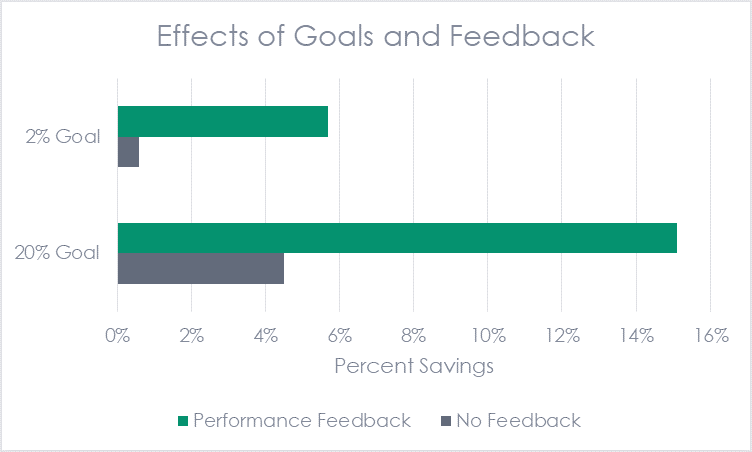
Featured Micro-Rant: Anyone who thinks or says, “We’re all efficient. The candy is gone. The cow is dry. The turkey is cooked. The apple tree died. It’s time to quit.” IS WRONG. (yes, that was me yelling) I believe, as demonstrated last week, that the greater savings and more cost-effective savings are waiting to be harvested through engagement and dispersion of timely, relevant information to energy users.
Let us continue from last week with discussions of how to arm building operators to slay their own drift of energy hogs. Information, inspiration, a little direction, and a destination are very powerful ingredients to energy management success – much more powerful than lightbulbs and variable frequency drives alone.
Last week we left off demonstrating impressive results using only the first two ingredients above: information and inspiration, aka, happy talk. Today we advance the discussion to include the destination, in the form of goal-setting. This is an interesting study, not just for saving energy[1].
The authors note that there is an implicit assumption that recipients of home energy reports have a goal to save energy or money. I can’t say this is true, but the source paper referenced in the footnote cites studies backing the assertion. However, I can say it is consistent with my statements of the past two weeks: that (1) when energy consumers have no monetary driver (goal) and (2) when they are merely compared to their diverse and unknown neighbor pool, very little happens. All that comes of it is the realization that recipients use energy and they can do something about it. Whoop dee doo.

How Goals Work
Operators of the 140 large office buildings were presented with energy-saving goals after:
- becoming aware of their energy use;
- learning how it tracks with weather and operating conditions;
- and self-learning or acting to already save energy.
Goal setting falls under the profession of organizational psychology and includes the following key elements for high performance:
- Goals direct attention away from irrelevant activities toward goal-relevant activities.
- Goals have an energizing and motivational component – the higher, the
- Goals invoke persistence, especially with the frequent and relevant feedback noted in last week’s post.
- Goals lead to discovery and task-relevant strategies to progress.
Residential Experiment
The paper cites studies that report performance (not to be confused with goal attainment) in relation to goal aggressiveness and a feedback loop of information. A famous test for residential energy users was conducted in 1978 to prove the point. Are smart thermostats, home energy management systems, smart strips, and sensors that read power 1 million times per second needed? No! (although to scale up, these would certainly help)
The test included four cases: high and low savings goals of 20% and 2%, and performance feedback versus lack of feedback. I love this: for feedback, customer analog meters were read three times a week and pasted on the kitchen window for customer engagement. Awesome!
The results are shown in the following table.
I direct your attention to two things:
- Performance and goal attainment are two completely different things. This is obvious. Customers with the higher goal trounced those with lower goals by almost 3x.
- Customers witnessing their progress matters – again, almost triple the impacts.
Remember, this level of success was achieved without instant or even “timely” feedback. These results were derived with manual analog meter readings three times a week and glued to customer windows – as in, glass, kitchen windows.

Large Commercial Buildings Findings
Moving back to the commercial study at hand, introducing goals into the soup proved to change trending energy use from a moderately increasing trend to a decreasing trend. Unfortunately, I cannot see that the authors included trends for the three key periods for participants: (1) status quo, (2) energy consumption versus expected (model), and (3) intervention with savings goals and specific messaging.
The paper concludes that savings of 20-30%, and sometimes more, are achievable with engagement through timely useful messaging and goal setting. Just think what could be accomplished with a little specific relevant direction! It is consistent with our experience – case studies in the making.
[1] Again, I thank the authors of the ACEEE paper, For Building Operators, What Difference Does a Target Make?, that I used as the basis for last week’s and this week’s posts.






Join the discussion One Comment